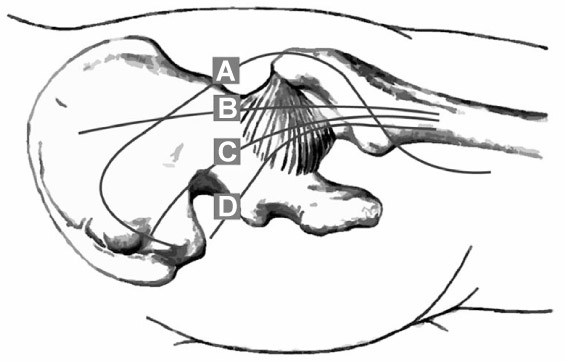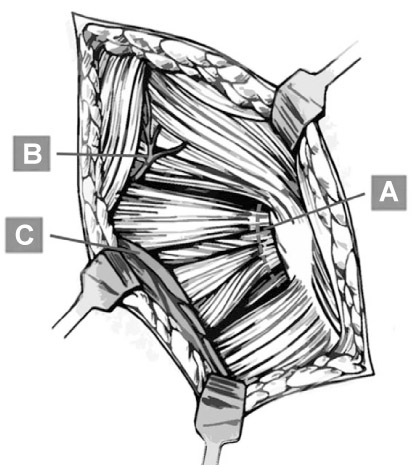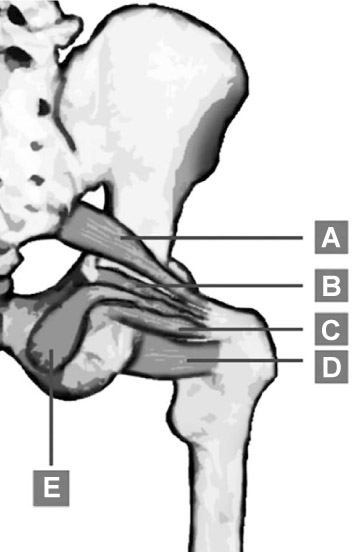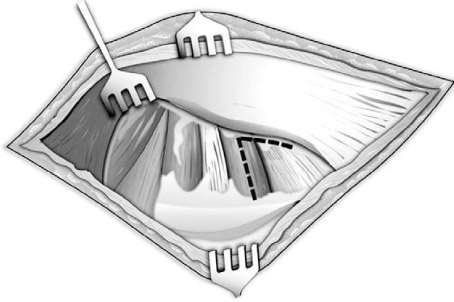J Korean Hip Soc.
2011 Sep;23(3):165-168. 10.5371/jkhs.2011.23.3.165.
Modified Posterior Approach to Total Hip Arthroplasty
- Affiliations
-
- 1Department of Orthopedic Surgery, Sun General Hospital, Daejeon, Korea. sundh@korea.com
- KMID: 2014881
- DOI: http://doi.org/10.5371/jkhs.2011.23.3.165
Abstract
- This paper reviews the posterior approach to total hip arthroplasty and introduces the modified short external rotator muscle saving posterior approach, which enhances hip stability after total hip replacement arthroplasty. In total hip replacement arthroplasty, dislocation is the most common early complication. Especially in the posterior approach, dislocation is more common than in the anterior or lateral approach to the hip. However, preservation or meticulous repair of the short rotator could reduce the incidence of posterior hip dislocation after total hip replacement arthroplasty. With a brief review of the posterior approach to the hip, we introduce the short external rotater muscle saving modified posterior approach to total hip arthroplasty.
MeSH Terms
Figure
Reference
-
1. Barber TC, Roger DJ, Goodman SB, Schurman DJ. Early outcome of total hip arthroplasty using the direct lateral vs the posterior surgical approach. Orthopedics. 1996. 19:873–875.
Article2. Callaghan JJ, Heithoff BE, Goetz DD, Sullivan PM, Pedersen DR, Johnston RC. Prevention of dislocation after hip arthroplasty: lessons from long-term followup. Clin Orthop Relat Res. 2001. 393:157–162.3. Kim HJ. Posterior approach in THA. J Korean Hip Soc. 2003. 15:308–311.4. Kim YS, Kwon SY, Sun DH, Han SK, Maloney WJ. Modified posterior approach to total hip arthroplasty to enhance joint stability. Clin Orthop Relat Res. 2008. 466:294–299.
Article5. Masonis JL, Bourne RB. Surgical approach, abductor function, and total hip arthroplasty dislocation. Clin Orthop Relat Res. 2002. 405:46–53.
Article6. McCollum DE, Gray WJ. Dislocation after total hip arthroplasty. Causes and prevention. Clin Orthop Relat Res. 1990. 261:159–170.
Article7. Mulliken BD, Rorabeck CH, Bourne RB, Nayak N. A modified direct lateral approach in total hip arthroplasty: a comprehensive review. J Arthroplasty. 1998. 13:737–747.
Article8. Pellicci PM, Bostrom M, Poss R. Posterior approach to total hip replacement using enhanced posterior soft tissue repair. Clin Orthop Relat Res. 1998. 355:224–228.
Article9. Suh KT, Park BG, Choi YJ. A posterior approach to primary total hip arthroplasty with soft tissue repair. Clin Orthop Relat Res. 2004. 418:162–167.
Article10. White RE Jr, Forness TJ, Allman JK, Junick DW. Effect of posterior capsular repair on early dislocation in primary total hip replacement. Clin Orthop Relat Res. 2001. 393:163–167.
Article11. von Knoch M, Berry DJ, Harmsen WS, Morrey BF. Late dislocation after total hip arthroplasty. J Bone Joint Surg Am. 2002. 84-A:1949–1953.
Article12. Won YY. Posterior approach of the hip joint. J Korean Hip Soc. 2006. 18:233–239.13. Woo RY, Morrey BF. Dislocations after total hip arthroplasty. J Bone Joint Surg Am. 1982. 64:1295–1306.
Article
- Full Text Links
- Actions
-
Cited
- CITED
-
- Close
- Share
- Similar articles
-
- Posterior Approach to Total Hip Joint Replacement Arthroplasty
- Anterior Approaches in Hip Surgery
- Heterotopic ossification following cementless total hip arthroplasty (direct lateral approach v.s. posterior approach)
- A pitfall for short external rotator preserving THA : A Case Report
- The History of Total Hip Arthroplasty





